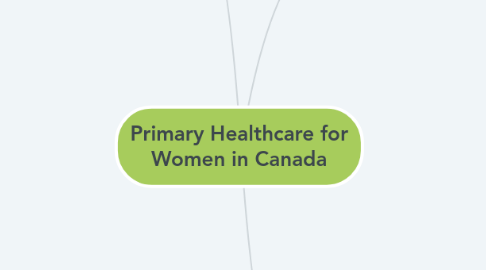
1. Primary care vs. primary health care
1.1. Primary care traditionally "focuses on care for acute, episodic problems and/or minor emergencies that could be dealt with outside of the hospital" (38).
1.2. Primary health care is a broader topic involving health promotion, disease prevention, and the management of chronic conditions
1.2.1. including private offices, community health centres, and clinics on the premises of community-based organizations (39).
1.3. Important to maintain a historical distinction
1.3.1. Primary health care aligns with aims of women's health reformers
1.3.1.1. ex. understanding pregnancy and birth as everyday life as opposed to medical events, inclusion of health promotion & disease prevention
1.3.1.2. the Alma Ata Declaration names primary health care a right, challenges government to address health inequities, and sees the link between health status and social conditions
1.4. "...in keeping with the spirit of primary health care...health care providers need to recognize the importance of women's diverse social locations and the context of their lives in order to understand and address women's access to, and needs for, primary care" (51).
1.4.1. Primary care reform as a process rather than an outcome (52) will allow a "trial and error" approach: not all
1.5. "Truly innovative primary care in Canada will integrate the best of the primary health care model with the principles and knowledge gained from a critical commitment to women-centred care" (57).
1.5.1. Though this chapter argues that women-centred care is essentially an exhaustive solution for primary care reform, is it entirely considerate of men?
1.5.1.1. I think it is important to consider the sex-related health issues that accompany men as well as women. I understand that this is maybe not the point of this chapter/text, but women-centred care fails to explicitly take into consideration the statistically lower life expectancy of men (and why this is the case), increasing mortality rates of prostate cancer (vs. breast cancer, for example) (Oke, 2018),
2. Primary care reform
2.1. historically with a focus on ensuring access to health care rather than researching determinants of health
2.1.1. Addressing determinants of health would, ironically, aid in the mission to enhance access to health care (because it would show providers WHERE and WHY certain services are required.
2.1.2. As well, enhancements are made by increasing the volume of family physicians/general practitioners in various ways (i.e. incentivizing medical students and practitioners)
2.1.2.1. While this may provide more easily accessible general healthcare, it does not solve the systematic issue of providing the appropriate care.
2.2. Further confuses the ideas of primary care and primary health care because ideally family physicians provide care beyond "acute, episodic problems and/or minor emergencies that could be dealt with outside of the hospital" (38).
3. Women as both patients and practitioners
3.1. Statistically women are main players in recent developments in primary care reforms in Canada
3.1.1. Women are more likely to be involved in a team approach to primary care (44)
3.1.2. Women (as patients) are more likely to make an informed decision and show interest in partenering with health care professionals. As doctors they are more likely to engage in patient-centred care (46).
3.2. Female practitioners help provide a safe space for female patients to seek help regarding gender- and/or sex-specific (or general) health concerns (48)
3.2.1. Factors such as religion, post-traumatic stress, and body dysmorphia can make women hesitant to see -or even prevent them from seeing - male practitioners.
3.2.1.1. In creating female-centred spaces (clinics, collaborative care centres, etc.), women will be encouraged and empowered to seek primary care. This will help contribute to health promotion and more accessible & exhaustive health care for women because women will seek care sooner instead of waiting until their symptoms are severe.

